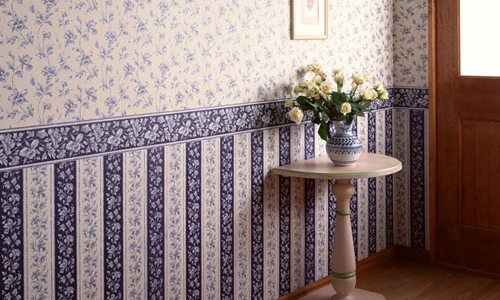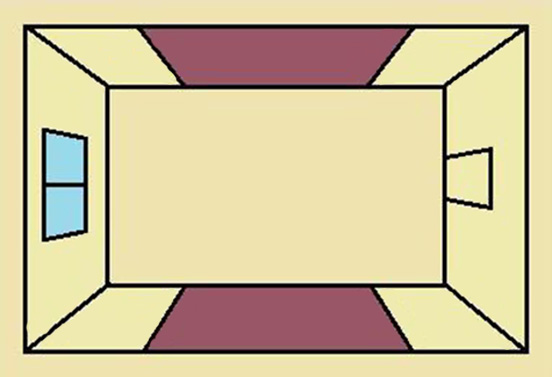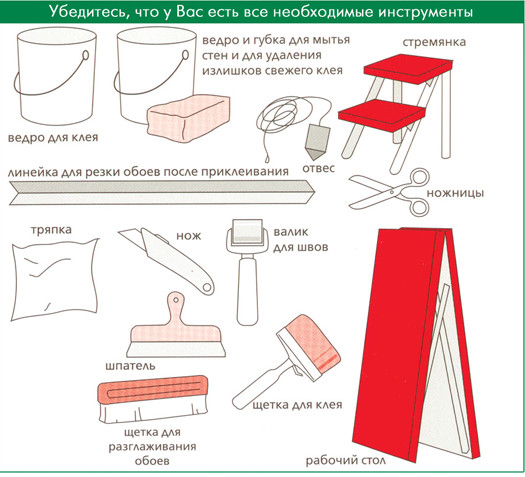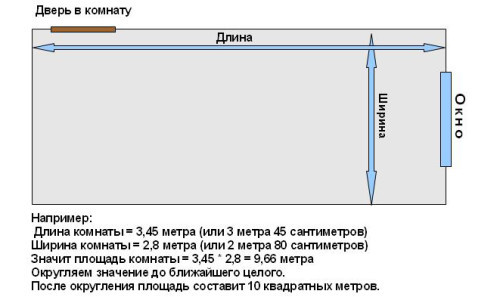For decorating walls according to all the rules todayvarious methods can be used. Pasting walls with combined wallpaper is an excellent option for decorating a room. Manufacturers offer numerous options for canvases, providing the widest range of finishing options. The use of one type of covering is still used today, but combination has become especially fashionable in recent years, i.e. a combination of several canvases that differ in texture, color, and the presence of a pattern. Depending on the level of natural light and the area of the room, you can use vertical or horizontal stripes, inserts, patchwork techniques, and other options. Combined wallpaper is the maincomponent of the interior of the room. The technique of pasting with a combined coating is not much different from traditional work, but the preparation and cutting will be slightly different. Before starting the activity, it is necessary to plan the walls of the room, determine which combinations will be used. It is important to consider what sizes of material need to be cut, how much of it will be needed.
Combined wallpaper is the maincomponent of the interior of the room. The technique of pasting with a combined coating is not much different from traditional work, but the preparation and cutting will be slightly different. Before starting the activity, it is necessary to plan the walls of the room, determine which combinations will be used. It is important to consider what sizes of material need to be cut, how much of it will be needed.
Variants of combining canvases
 Scheme of standard wallpaper combination inroom. There are many combination options, among them we can highlight the basic ones, which are modernized depending on the interior and decor features. Most often, vertical and horizontal stripes are used. The first option is well suited when you need to visually increase the height of the ceiling, to accentuate a certain part of the room. The stripes can be of different thicknesses, they can have a contrasting color, ornament and pattern, the use of different textures is allowed. Horizontal combination can be used for spacious rooms to give them more comfort. Usually this is an option when the lower part is decorated in a darker color, and the upper one - in light colors. Molding or a dividing strip is glued in the middle. A combination of plain stripes will look original. Patchwork technique has also been popular in recent years, with its help you can decorate any room, make it brighter, more attractive. It consists in the fact that the surface is pasted over in a correct or chaotic order with elements of wallpaper of different colors and textures. Inserts and photo wallpapers allow you to give the room the necessary mood, they can be very different. Photo wallpapers are usually pasted on the entire surface of one wall, but can also be used as a large insert. They can be replaced with canvases with an ornament. Return to the table of contents</a>
Scheme of standard wallpaper combination inroom. There are many combination options, among them we can highlight the basic ones, which are modernized depending on the interior and decor features. Most often, vertical and horizontal stripes are used. The first option is well suited when you need to visually increase the height of the ceiling, to accentuate a certain part of the room. The stripes can be of different thicknesses, they can have a contrasting color, ornament and pattern, the use of different textures is allowed. Horizontal combination can be used for spacious rooms to give them more comfort. Usually this is an option when the lower part is decorated in a darker color, and the upper one - in light colors. Molding or a dividing strip is glued in the middle. A combination of plain stripes will look original. Patchwork technique has also been popular in recent years, with its help you can decorate any room, make it brighter, more attractive. It consists in the fact that the surface is pasted over in a correct or chaotic order with elements of wallpaper of different colors and textures. Inserts and photo wallpapers allow you to give the room the necessary mood, they can be very different. Photo wallpapers are usually pasted on the entire surface of one wall, but can also be used as a large insert. They can be replaced with canvases with an ornament. Return to the table of contents</a>
Helpful Tips
 Wallpaper pasting tools.When creating a combined covering, it is necessary to take into account that the combination of different wallpapers makes it possible to transform the room, visually making it larger and more spacious. Experts advise using the following techniques:
Wallpaper pasting tools.When creating a combined covering, it is necessary to take into account that the combination of different wallpapers makes it possible to transform the room, visually making it larger and more spacious. Experts advise using the following techniques:
Return to Contents</a>
Patchwork technique in the interior
 Calculation scheme for the area of the room for gluingwallpaper. Today, combining wallpaper in a patchwork technique is popular. This technique is attractive and unusual, the room acquires a playful appearance. It is necessary to start pasting using different pieces with the selection of canvases. If you need to wallpaper a children's room for a girl, it is better to take light colors. For example, 2-3 shades of pink, light blue, white. The main tone will be pink, for combining you need to take 3-4 wallpaper options. For work you will need:
Calculation scheme for the area of the room for gluingwallpaper. Today, combining wallpaper in a patchwork technique is popular. This technique is attractive and unusual, the room acquires a playful appearance. It is necessary to start pasting using different pieces with the selection of canvases. If you need to wallpaper a children's room for a girl, it is better to take light colors. For example, 2-3 shades of pink, light blue, white. The main tone will be pink, for combining you need to take 3-4 wallpaper options. For work you will need:
You need to start work by selecting tools and materials:
- wallpaper of the selected type;
- adhesive for wallpaper;
- a container for mixing glue;
- drill with a "construction mixer" attachment;
- roller or brush for applying glue;
- a simple pencil;
- metal ruler;
- building level for marking walls;
- A sharp knife with replaceable blades;
- lining material, for example, a plywood large sheet, for cutting wallpaper;
- A cardboard from which a template for elements of pasting of a wall will be cut out.
Pasting walls with different wallpapers begins with calculationsand marking the wall. Before this, you need to take measurements of each wall, and then make a sketch of the future covering on a sheet of paper. Next, you should determine what dimensions each square will have, for example, 40 * 40 cm. Based on the desired size for one element, you should make a breakdown on the sketch. Then numbers are applied to the diagram for all types of wallpaper. For example, for plain squares, the number "1" will be used, for coverings with a floral pattern - the number "2". This is necessary so that pasting the walls with different wallpapers is done as accurately and quickly as possible, while maintaining accuracy and the original idea. Return to contents</a>
The process of patching walls
Using a building level, metalruler and a simple pencil, it is necessary to make markings on the surface of the walls according to the previously made sketch. Then, according to the previously prepared template, it is necessary to cut squares. To give the room expressiveness, you can use strips of wallpaper of the same type for the corners. They will be glued first from the floor to the ceiling. From them, you can already start gluing the flaps. The glue is diluted in a prepared container with an electric drill with a "construction mixer" attachment. The proportions are indicated by the manufacturer on the packaging, the type of glue is selected depending on the wall covering. The glue is applied to the wall surface with a brush or roller. The sheet is pressed tightly, rolled with a roller so that no air bubbles remain. In this way, the walls are pasted with different wallpapers along the perimeter of the entire room. It is not at all necessary to paste over the entire room with flaps, it is quite enough to make one wall near the bed like this, and decorate the rest of the space with a different type of covering. Everything depends on your imagination, the style of the nursery, and the options for its general decoration. Pasting with combined coverings - This is quite an interesting option. You can use horizontal or vertical stripes, inserts, patchwork technique for this. The process of pasting is almost no different from the usual finishing, but the utmost attention should be paid to marking the surface.


